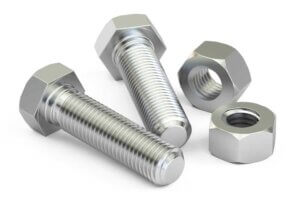
 Nuts and bolts are common fasteners used to join or secure two or more objects together. They are an essential component in construction, manufacturing, and various DIY projects. Here’s a brief overview of nuts and bolts:
Nuts and bolts are common fasteners used to join or secure two or more objects together. They are an essential component in construction, manufacturing, and various DIY projects. Here’s a brief overview of nuts and bolts:
Bolts: Bolts are threaded fasteners with a head at one end and a threaded shank at the other. The shank typically has external threads that allow it to be inserted into a hole or threaded into a nut. Bolts come in various shapes, sizes, and materials, each designed for specific applications.
Nuts: Nuts are threaded fasteners with a hole in the center. They have internal threads that match the external threads on bolts. Nuts are used in conjunction with bolts to secure objects together. There are different types of nuts, such as hex nuts (with six sides) and wing nuts (with two “wings” for hand-tightening).
Threads: Threads are the helical ridges on the shank of the bolt and the internal surface of the nut. They allow the bolt and nut to be twisted together, creating a strong and secure connection.
Fastening Process: To use nuts and bolts, you insert the bolt through a hole in one object and then thread the nut onto the exposed shank of the bolt. By turning the nut, you create tension between the two objects, holding them firmly together.
Types and Materials: Nuts and bolts come in various types, including machine bolts, carriage bolts, hex bolts, and more. They can be made from different materials like steel, stainless steel, brass, aluminum, and plastic, with the choice of material depending on factors such as strength, corrosion resistance, and application.
Sizes: Nuts and bolts are available in a range of sizes, with standardized threads (e.g., metric or imperial) to ensure compatibility between different components.
Washers: Washers are often used in conjunction with nuts and bolts. They are thin, flat disks with a hole in the center. Washers help distribute the load and provide a smooth surface for the nut to press against. This can prevent damage to the materials being fastened and improve the integrity of the connection.
Torque: When tightening nuts onto bolts, the appropriate level of torque (twisting force) is crucial to ensure a secure connection without damaging the components.
Nuts and bolts are versatile and can be found in countless applications, from assembling furniture and vehicles to constructing buildings and bridges. Choosing the right type, size, and material is essential to ensure the strength and longevity of the connection in any given project.
